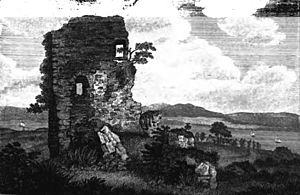Easter Greenock Castle facts for kids
Easter Greenock Castle was an old castle in Greenock, Scotland. We don't know exactly what it looked like. It was an important building in its area for many years.
Contents
What Was Easter Greenock Castle?
Easter Greenock Castle was built around the mid-1500s. It was the main building for the lands of Cartsburn and Easter Greenock. These lands were owned by the Crawford family from Kilbirnie in Ayrshire. They got the land when Mary, Queen of Scots was queen.
The Cartsburn area stretched from the Carts Burn river along the River Clyde. It was a significant part of the Kilbirnie lands. Over time, a younger branch of the Crawford family took over these lands. Their ownership ended with David Crawford during the time of King Charles I.
The Crawfords and Their Lands
By the mid-1600s, John Crawford of Kilbirnie owned the lands of Cartsburn and Cartsdyke. King Charles I made him a baronet in 1641. This was because John Crawford had helped the King during the Wars of the Three Kingdoms. He passed away in 1662.
John Crawford had two daughters, Anne and Margaret, with his second wife. Anne married Sir Archibald Stewart. Margaret married Patrick Lindsay, whose father was the Earl of Crawford. The lands were set up so Margaret and her male children would inherit them. They also had to use the Crawford family name and coat of arms.
How the Lands Changed Hands
In 1663, Margaret Crawford officially received the lands of Kilbirnie from her father. This included the Cartsburn area, with its buildings and fishing rights. It also gave her access to the moor and marsh of Greenock. This document allowed Margaret and her heirs to sell parts of Easter Greenock and Cartsburn.
In 1669, Margaret Crawford, now known as Lady Kilbirnie, sold Easter Greenock to Sir John Schaw. He owned Wester Greenock. In 1670, a special royal document was issued. It said that Easter and Wester Greenock would become one large area called the Burgh of the Barony of Greenock.
However, Lady Kilbirnie kept the rights to Cartsburn. She later gave these rights to her cousin, Thomas Crawfurd. He was the second son of Cornelius Crawford of Jordanhill. Thomas later became the first Baron of Cartsburn. Old documents about the Cartsburn lands from 1628 to 1656 still exist today. You can find them in the National Archives of Scotland in Edinburgh.
The name Cartsdyke might come from "Crawford’s Dyke." This was named after John Crawford of Easter Greenock. He built a quay wall, or dyke, in Greenock in the mid-1500s.
The Barony of Cartsburn
Cartsburn became its own special area, called a barony. It was also given the right to hold a weekly market and several fairs. King Charles II granted this to Thomas Crawfurd of Cartsburn in 1669.
South of Crawfordsdyke was the House of Cartsburn. This was the main house of the barony and where the Crawfords of Cartsburn lived. One of the earliest descriptions of Cartsburn comes from a book written in 1710. The author, Hamilton of Wishaw, said that the town was "a very thriving place." He noted that many merchants, sailors, and traders had built good houses there.
The Castle's End
In 1809, The Scots Magazine reported that the castle's tower had fallen. It suggested that soon, farms might even cover its remains. However, it was the Industrial Revolution that truly led to the castle's final destruction.
The castle's ruins were in the way of the new railway. So, they were torn down in the 1830s. Today, the only reminder of Easter Greenock Castle above ground is a street called Castle Road.


